Products
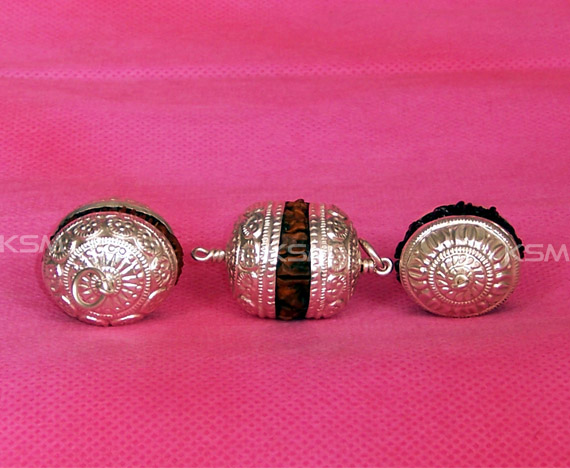
Rudraksha Beads
Rudraksha (Sanskrit: rudr k a) ("Rudra-eyed") also spelled as Rudraksh are seeds that are traditionally used to make prayer beads and are borne by several species of Elaeocarpus with E. ganitrus being the principal species used in the making of a bead chain or mala. (Sanskrit: m l ). The word is a Sanskrit compound consisting of the name Rudra and k a ("eye"). The Latin species epithet ganitrus is possibly taken from ganitri, the name for this species in Sundanese and Malay.
The Rudraksha is a large evergreen broad-leaved tree that grows in the area from the Gangetic Plain in foothills of the Himalayas to South-East Asia, Indonesia, New Guinea to Australia, Guam and even Hawaii. Rudraksha trees are also found in middle areas of Nepal. Rudraksha seeds are covered by an outer shell of blue color when fully ripe, and for this reason are also known as blueberry beads. The blue colour is derived not from pigment but is structural. A rare fourteen face Rudraksha bead set in Gold It is an evergreen tree that grows quickly. Rudraksha Tree starts bearing fruit in three to four years. As the tree matures, the roots buttress rising up narrowly near the trunk and radiating out along the surface of the ground giving a gnarly and prehistoric appearance.
Rudraksha Beads
Rudraksha beads are the material from which garlands (108 beads in number) are made. The term is used both for the berries themselves and as a term for the type of m l made from them. In this sense, a rudraksha is a Saivite rosary, used for japa mala. Repetitive prayer (japa) is a common aid to worship in Hinduism, and Rudraksha m l are worn by many Hindus.[citation needed] Rudraksha is also used for treatment of various diseases in traditional Indian medicine. The seeds show variation in the number of grooves on their surface, and are classified on the basis of the number of divisions that they have. A common type has five divisions, and these are considered to be symbolic of the five faces of Shiva. Rudraksha seeds should be protected from chemicals. Rudraksha seeds (beads) are used for spiritual mala or rosary such as in Hindu and Buddhism. Rudraksha trees are grown in the Himalayan villages of Nepal (the native homeland of Rudraksha) which are favored and valued more than other Rudraksha malas.
Religious Use
Rudraksha mala has been used by Hindus (as well as Sikhs and Buddhists) as rosary for thousands of years for meditation purposes to sanctify the mind, body and soul. The word Rudraksha is derived from Rudra (Shiva—the Hindu God of all living creatures) and aksha (eyes). So, Rudraksha is related to Shiva’s eyes. One Hindu mythology says that once Lord Shiva became so compassionate after seeing the sufferings of mankind that He could not stop to shed tear from his eye. This single tear from Shiva’s eye grew into the Rudraksha tree. Rudraksha fruit is green in color but turns black when dried. The central hard Rudraksha uniseed may have 1 to 21 faces. The five-faced Rudraksha seeds are the most common.
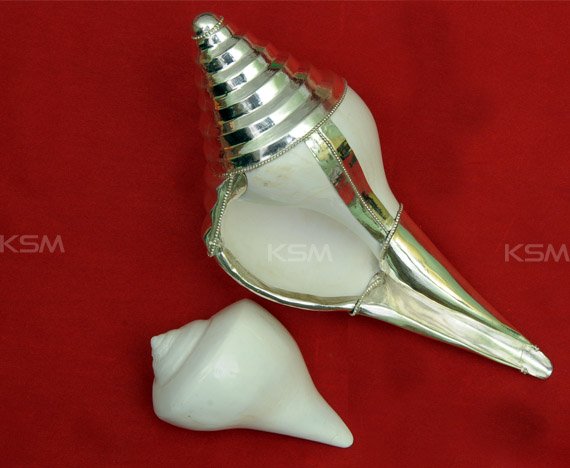
Valamburi Shangu
We also have Valamburi shangu(Conch), Salagramam, Bhanalingam, Mercury(Paatha rasam), Ganesha idols & Mahameru in Emerald, Coral, Spatika and moon stone. All things needed for the Idol Alangaram(Make Up), such as Kreedam(Crown), Dress Mugam (Face) are also available. Items needed for temples such as Bells, Kalasam, Arch(Prabhavali/Thiruvachi) are also available. Artistic Idols are also available with us. These handcrafted idols are exquisitely beautiful. Vel(Spear) and Sulem(Trident) are also available in all sizes in copper,brass & Panchalokam.
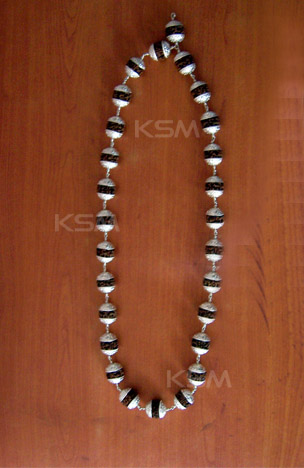
Rudraksha Mala
We have Spatika, Rudraksha, Thulasi, Sandal, Navarathna, Pearl, coral malas. Lockets of all deities are also available with us in Silver and Copper.
Rudraksha Beads
A Mala is a string of beads used to count mantras (Sanskrit prayers) in sets of 108 repetitions
A mantra is a word or series of words chanted aloud or silently to invoke spiritual qualities. Chanting is used as a spiritual tool in virtually every cultural and religious tradition. In the yogic tradition a mantra is a Sanskrit word that has special powers to transform consciousness, promote healing or fulfill desires.
The practice of chanting a mantra is used as a form of meditation. Sitting in a comfortable position, with the eyes closed, the mantra is repeated silently or aloud. The mind is focused on the mantra, the thoughts are let go of and the breath is slow and deep.
Hold your mala in your right hand and use your thumb to “count” each mantra by touching the bead during the recitation and then lightly pushing the bead away on completion and moving to the next bead. The index finger is extended and should not touch the mala. The large meru (mountain) bead should not be counted or touched by the thumb and is used as a starting and ending point of the recitation. If you have a wrist mala of 27 beads you will need to repeat this 3 more times. Continue by pulling the beads and going backwards until you again end at the meru and continue until you have done 108 repetitions, or multiples of 108.
To empower the mala and the mantra used, japa (mantra meditation) should be practiced each day for 40 continuous days. When the mala becomes empowered it can be worn or lightly placed on oneself or others to transmit the energy of the mantra as well as the energetic qualities of the mala. When you use a new mantra with a mala, this energy becomes replaced, so it is recommended to use a new mala with each mantra if possible.
When not in use, store your mala in a special, clean and preferably sacred space. The best place to store a mala is on a personal alter or statue of a deity.
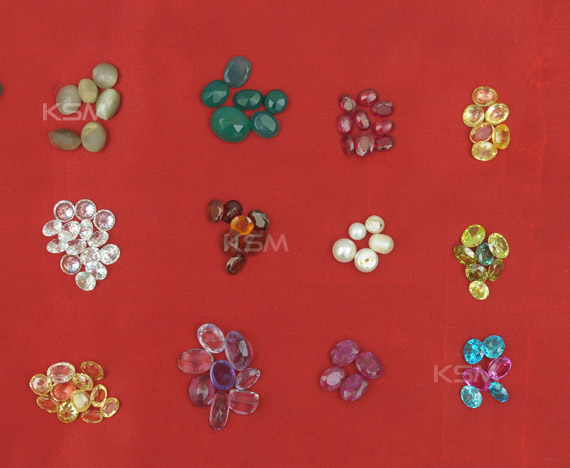
Gemstone
A gemstone or gem, also called a precious or semi-precious stone, is a piece of attractive mineral, which — when cut and polished — is used to make jewelry or other adornments. However certain rocks, (such as lapis-lazuli) and organic materials (such as amber or jet) are not minerals, but are still used for jewelry, and are therefore often considered to be gemstones as well. Most gemstones are hard, but some soft minerals are used in jewelry because of their lustre or other physical properties that have aesthetic value. Rarity is another characteristic that lends value to a gemstone. Coral, Diamond, Emerald, Pearl, Ruby, Topaz, Sapphire, Garnet, Cat's eye, Moon Stone, Amethyst are available with us. All the above mentioned stones are available in Rings in Silver and Panchaloka
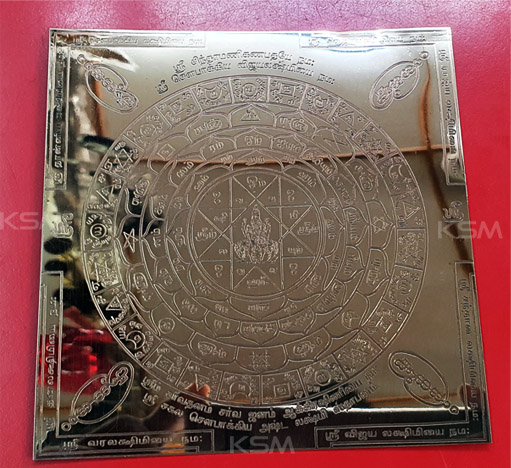
Yanthras
Yanthras are available in copper and panchaloka. We have more than 200 types of yanthras. Some of them which you may find rare are Hayagreevar, Varaagi, Lakshmi Narasimhar, Mrithyunjai, Prithyangara, Swarna Bhairavar, Sarabheshwarar, Suyamvara Parvathi, Rajagopalan, Janavasiyam. And some of the common Yanthras are Shree Chakra, Subramaniyar, Ashtalakshmi, Lakshmi Kuberan, Vaasthu, Pancha siras, Sathrusamhara, Maha sudharshanam, Malayala Sudharshanam, Karuppannasamy, Muneeswarar. We also have Muslim and Christian Yanthras. All these are available in 2x2, 4x4, 6x6 & 12x12 sizes and in both copper & panchaloka
